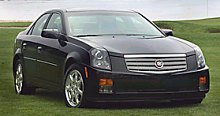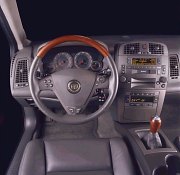 In
Chinese we say "Failure is the mother of Success". That means without
experiencing
failures you are unlikely to achieve success. Also, you have to learn
from
failures rather than repeating them. Failures are nothing new to GM's
Cadillac
division since it tried to re-engineer its image in the 80s - from the
Pininfarina-styled Allante coupe, high-tech Seville STS to the Opel
Omega-derived
Catera, all are flops, or at least fail to meet sales target. Will the
new CTS be another inevitable failure, just repeating history? there is
hope, because the new baby Caddy seems learning from the past at last,
or more correctly speaking, learning from the successful BMW to inject
real driver appeal to the chassis. They designed the basic Sigma
platform
in Australia - by Holden in the fame of Commodore VT, then covered it
with
an edge-cutting "Art-and-Science" design originated in Evoq prototype,
installed a nice Opel V6 into the engine bay together with a Getrag 5M
or a world-class 5A ... lastly, and most important, the chassis and
suspensions
tuning were carried out in Germany's Nurburgring race track. Perhaps
the
name CTS is also chosen to imply "Converted To Succeed". See, this time
GM is really serious to rebuild the image of Cadillac. In
Chinese we say "Failure is the mother of Success". That means without
experiencing
failures you are unlikely to achieve success. Also, you have to learn
from
failures rather than repeating them. Failures are nothing new to GM's
Cadillac
division since it tried to re-engineer its image in the 80s - from the
Pininfarina-styled Allante coupe, high-tech Seville STS to the Opel
Omega-derived
Catera, all are flops, or at least fail to meet sales target. Will the
new CTS be another inevitable failure, just repeating history? there is
hope, because the new baby Caddy seems learning from the past at last,
or more correctly speaking, learning from the successful BMW to inject
real driver appeal to the chassis. They designed the basic Sigma
platform
in Australia - by Holden in the fame of Commodore VT, then covered it
with
an edge-cutting "Art-and-Science" design originated in Evoq prototype,
installed a nice Opel V6 into the engine bay together with a Getrag 5M
or a world-class 5A ... lastly, and most important, the chassis and
suspensions
tuning were carried out in Germany's Nurburgring race track. Perhaps
the
name CTS is also chosen to imply "Converted To Succeed". See, this time
GM is really serious to rebuild the image of Cadillac.
CTS is roughly in the same size as a BMW 5-series, just having 50mm longer wheelbase and overall length. However, GM will price it aggressively to rival the high-end 3-series instead, once again proofing the fact that poor brand image and inferior quality pay the price. Anyway, when it goes on sale in Europe, the price gap between it and 5-series will be narrowed to negligible because the distribution and promotion cost there will favour the BMW. So I will still see it as a competitor of 5-series.
The chassis is all new, developed primarily by Holden to adapt to different usages across GM's line-up, such as the next Commodore and Cadillac Seville (CTS's big brother). While it may not be the most sophisticated platform from GM, it is rear-wheel drive and employs front double wishbones and rear multi-link suspensions so that handling can be optimized. Moreover, the monocoque is designed to be very rigid, capable of handling rough Australian roads as well as demanding driving style of European car nuts. This sounds like a press release, but several European magazines invited to test drive it in Nurburgring gave it very positive comments. The European test cars were equipped with sports pack including stiffer suspension setup, self-leveling rear shock absorbers, 225/50VR17 tyres and speed-sensitive power steering. Testers found the CTS has a sweet steering offering plenty of feel and sharp turn-in. Ride is a bit firmer and harsher than BMW but never fidget. The chassis balance well while the suspensions keep rubbers firmly on road so that cornering limit is surprisingly high. The highly rigid chassis seems able to cope with a V8 powerplant. Brakes are also excellent, no matter power or pedal feel. Most CTS sold will be powered by Opel Omega's 54° V6, which has been upgraded to 3.2 litres. Compare with the previous 3-litre, it gains longer stroke, a modified head and a new 2-stage variable-length manifold to achieve 220 horsepower and 218 lbft of torque. The engine is silky-smooth and quiet, works eagerly with Cadillac's first 5-speed manual in 20 years. The Getrag-supplied transmission is reasonably slick and have close ratio to enhance acceleration, but the V6 is not torquey enough to trouble BMW 530i. Therefore choosing the 5-speed self-shifter may be a better idea, at least it is exactly the same gearbox using by the 5-Series. As some of you might know, GM's subsidiary Delphi makes one of the world's best 5-speed automatic transmissions but the box is just supplying to BMW rather than to GM itself because none of GM's existing cars were designed to mate that. Now CTS finally enjoys the superb box.
No matter how
many previous
attempts failed, Cadillac's latest effort will be different. In the
past,
it just talked about this and that but never really carried out. This
time
we saw it really comes true. CTS is not just following the footprints
of
Lincoln LS to shift to European's territory, but its intention is more
serious and the efforts made are far greater. If Lexus IS300 can
succeed,
why not the baby Caddy ? let's hope so. |
| The above report was last updated on 11 Sep 2001. All Rights Reserved. |
 As
aforementioned, the exterior styling evolves from the Evoq show car,
sharing
the same angular and polygon-surface profile and a new trademark
grille.
It is a little bit bland, a little bit bulky, blame to high shoulder
line.
On the plus side, it feels solid and distinctive. Inside, the dashboard
design is no less unique, having a driver-oriented big block acts as
center
console. There is reasonable amount of space by class standard, but
here
you can also see traces of cost reduction - poor quality of plastics,
cheap
switch gears and some plasticky fake alloy decorating the gauges. If
there
are anything GM did not learn from the past, the first thing must be
interior
materials and build quality.
As
aforementioned, the exterior styling evolves from the Evoq show car,
sharing
the same angular and polygon-surface profile and a new trademark
grille.
It is a little bit bland, a little bit bulky, blame to high shoulder
line.
On the plus side, it feels solid and distinctive. Inside, the dashboard
design is no less unique, having a driver-oriented big block acts as
center
console. There is reasonable amount of space by class standard, but
here
you can also see traces of cost reduction - poor quality of plastics,
cheap
switch gears and some plasticky fake alloy decorating the gauges. If
there
are anything GM did not learn from the past, the first thing must be
interior
materials and build quality.  Pushing
nearly 1600kg, it is quite doubtful whether the manual CTS can sprint
to
60mph in under 7 seconds as claimed. Therefore a more powerful engine
is
always welcomed. It is understood that a 240hp version of the V6 will
be
added later on, so is a new generation small-block 4.3-litre V8 with
unique
3-valve heads operated by pushrods. At the other extreme, Europe will
be
offered a fuel-efficient 2.6-litre V6 (now serving the Vectra). By
then,
the CTS will become a complete line-up.
Pushing
nearly 1600kg, it is quite doubtful whether the manual CTS can sprint
to
60mph in under 7 seconds as claimed. Therefore a more powerful engine
is
always welcomed. It is understood that a 240hp version of the V6 will
be
added later on, so is a new generation small-block 4.3-litre V8 with
unique
3-valve heads operated by pushrods. At the other extreme, Europe will
be
offered a fuel-efficient 2.6-litre V6 (now serving the Vectra). By
then,
the CTS will become a complete line-up.  When
GM product chief Bob Lutz talked about building a Cadillac to rival
BMW’s
M-cars, no one believed. Obviously he was crazy, wasn’t he? not really.
This guy is not only a "car guy" but also a sensible one. He knew
Cadillac
CTS is a credible basis for such a performance car. He knew the
Chevrolet
division can provide a powerful V8 to fulfil this task. He knew inside
the GM empire there are still some world-class engineers who are
capable
and eager to take this challenge. Therefore he formed the "Performance
Division" and put John Heinricy - the assistant chief engineer of
Corvette
C5 - to head it. CTS-V is born out of this division.
When
GM product chief Bob Lutz talked about building a Cadillac to rival
BMW’s
M-cars, no one believed. Obviously he was crazy, wasn’t he? not really.
This guy is not only a "car guy" but also a sensible one. He knew
Cadillac
CTS is a credible basis for such a performance car. He knew the
Chevrolet
division can provide a powerful V8 to fulfil this task. He knew inside
the GM empire there are still some world-class engineers who are
capable
and eager to take this challenge. Therefore he formed the "Performance
Division" and put John Heinricy - the assistant chief engineer of
Corvette
C5 - to head it. CTS-V is born out of this division.